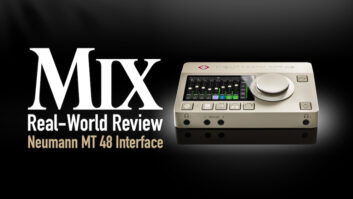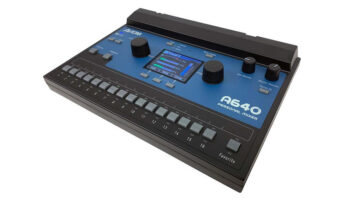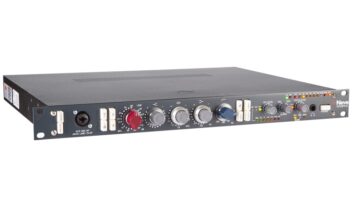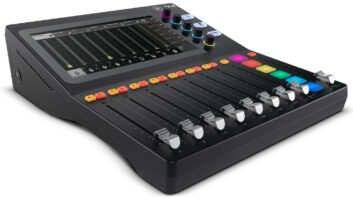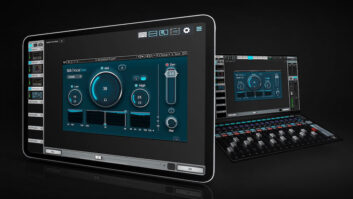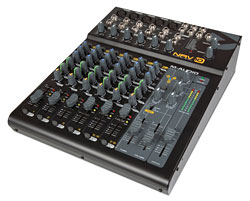
Not every musician has made the leap into the world of mixing in the box. Many of us still have keyboards, sound modules and outboard processors that need to be mixed with our virtual tracks. We also occasionally need to take our gear on the road and merge it into a laptop-based performance setup. The M-Audio NRV10 ($899.95) seems to have been built with just this dual-purpose, studio-to-stage transition in mind.
Intended to operate as a true front and back end to any computer recording setup, the NRV10 combines an 8×2 analog mixer with a 10×10 FireWire S 400 audio interface that supports up to 24-bit/96kHz audio. Unlike many other devices that have treaded similar paths recently, the NRV10 has plenty of signal routing muscle. Not only can its mic pre’s and EQs be included on a signal’s way in or out of the computer, but you can also monitor your MIDI-sequenced outboard synths with effects applied by your favorite VST plug-ins (without first having to record them as audio tracks). Plus, an onboard digital effects system provides latency-free direct monitoring for live P.A./DJ mixing or studio tracking scenarios.
I, O AND COMPACT Q
Packed into an 11×14-inch footprint (W×D) are four phantom-powered XLR/TRS mic/line channels with inserts (inputs 1 through 4), two stereo channels (5/6 and 7/8) and a virtual stereo FireWire 9/10 channel, which is quite special to the NRV10’s overall flexibility. As a bonus, input 5 of the stereo channels sports a fifth XLR and mic preamp, minus the insert jack.
Each physical input channel has a 3-band EQ with frequency centers at 80 Hz, 2.5 kHz and 12 kHz, delivering ±15 dB of boost per band. Together with the beefy channel gain, you’ll have no problem contouring even problematic signals with these clean, powerful and full-sounding EQs. The NRV10’s channel mutes, located just below the faders, double as cue bus assigns. I appreciated having the red peak-warning and yellow mute-status indicator LEDs beneath each pan/balance knob, but the lack of channel solo function disappointed me.
Surprisingly flexible despite its simplicity, the master section features individual faders for ‘phones, control room and main mix levels. Headphones can be sources from the main mix, the cue bus or the aux 1 monitor mix. Aux 1 is used primarily to set up a monitor mix in headphones, and aux 2 (DFX) automatically gets routed to the internal digital effects. Plug in stereo return cables, though, and either auxiliary will convert to the physical mono send jacks, letting you use outboard processors in the conventional way. Master section indicators include a 13-step stereo LED meter with clip, a global phantom-power indicator and — emblazoned by a large, yellow silk-screened FireWire logo — an LED that illuminates bright blue whenever FireWire streaming is activated.
Rear panel connectivity is as it should be on a compact mixer: tidy with only main mix outputs (balanced and unbalanced XLR and ¼-inch), control room outputs (¼-inch), TRS inserts across the mains and a pair of FireWire jacks for daisy-chaining. Not FireWire bus-powered, the line-lump power supply is appreciated, but I hate universal adapter-style jacks on live equipment as they’re eternally prone to becoming loose and being yanked free in the middle of a set.
MORE ‘VERB IN THE CANS
The NRV’s built-in digital effects processor functions in either stand-alone or FireWire mode, including signals returning from the computer over the digital bus. Sporting several algorithms but capable of only one effect at a time, the DSP is strictly preset-based and is not editable. You have a choice of 16 different programs, including short and regular room, small and large hall, cathedral, short plate and vocal plate, mono and stereo echo, medium and deep chorus, and flange, as well as three combination algorithms. Each program then has up to 16 variation settings, offering different reverb and delay times, flange or chorus depths, etc.
Although the effects are decent sounding, they are obviously intended for use in live situations where a utility vocal plate or synth-fattening chorus can become convenient in a pinch. In the studio, while I don’t think anyone would choose these over their favorite plug-ins or outboard for a critical mix, using them in the musician’s headphones during tracking makes complete sense, especially with the zero latency and impact to the CPU of direct monitoring.
STREAM TEAM
Running the included Pro Tools M-Powered 7.3.1 (you can use any compatible DAW or music software) on an Intel Core Duo 2.2GHz MacBook Pro, I tested the NRV10 in two distinct scenarios: as a studio mixer in an urban pre-production setting and as a tool kit for a multimedia performance event. From the installer disc, I first loaded M-Audio’s streamlined Control Panel application. This offers only the basic necessities of an audio driver, such as I/O metering, sample rate and buffer-size selection; mixing and routing are left up to your DAW. A second utility called NRV10 interFX, created by M-Audio and Audiffex, is a small-footprint, submixer-type application intended to host VST plug-ins in a live setting. It provides gain, dynamics/gate control and up to two VST insert slots per analog input channel coming over FireWire from the NRV10.
Adorning the top of each of the mixer’s six channel strips is a button labeled CH/FW, which toggles the input between the NRV10’s physical jacks and the corresponding FireWire path from the computer. This allowed me to monitor and record my keyboards, Akai MPC4000, turntable and microphones, and then switch any of the NRV10’s input paths to accept recorded tracks returning from the DAW. The mixer’s physical inputs are always streamed to the computer, regardless of the CH/FW setting.
In this combined workflow, I was able to fly about, listening to playback and punching in new parts, all the while mixing both live and recorded inputs side-by-side using the NRV10’s faders and EQ. What’s more, with the record buffer set low enough, I could even monitor some or all live inputs using Pro Tools’ plug-in effects, which essentially function as inserts on the NRV10’s physical channels. If you prefer to keep your DAW tracks mixed entirely in the box, the handy FW 9/10 bus acts as a third stereo input to the NRV10 (without consuming any physical inputs), allowing you to blend this mix with the headphone and control room outputs for flexible monitoring control. Conversely, the FW 9/10 return to the computer allows you to record the whole shebang (NRV10’s main mix) to a stereo file in your DAW when you’re done.
For the multimedia performance, I had to combine three elaborate stereo studio stems with live input from my small keyboard rig, a video-to-audio conceptual artist, a Continuum Fingerboard artist and one acoustic instrumentalist. The latter two began the set solo, so I fed them each a guide track to their ear buds. Using the multichannel output of the M-Audio driver, I was able to route a click on FW 9/10 along with the prerecorded Pro Tools tracks or groups back to the NRV10 on discrete channels for CPU-free monitoring and live mixing. This allowed me to adjust levels and EQ, and to add onboard effects at the mixer alongside the microphones and all my physical input hardware gear — a great feature if you play many different venues, as it allows you to tweak your setup on the fly without altering your original session file each time.
We finished our set with an impromptu jam, so I bailed out of Pro Tools and ran only the interFX software. This allowed me to take the same plug-in effects I’d been using in the studio straight to the stage, complete with manual snapshot recall. The real-time streaming, back and forth across the multiple channel buses, is lightning-fast and presented no perceivable latency to my ears.
A HAPPY MARRIAGE
The NRV10 is a concept that’s been a long time coming, and one that I’m personally thrilled to see working this well. As an analog mixer, the NRV10 sounds large and impeccably clean, although it’s not entirely decked out to the extent of some standard compacts in its price range. Throw in its digital side, however, and you have an unprecedented level of FireWire integration and functionality that seamlessly moves you from studio to stage.
For any computer-based recording setup, an NRV10 blurs the line between writing and pre-production, through to recording, overdubbing and mixing. For laptop musicians, however, being able to manageably tote five quality preamps, a dutiful and tactile mixing surface, and 20 channels of digital audio under one arm is pure luxury.
M-Audio, 626/633-9050, www.m-audio.com.
Jason Scott Alexander is a producer/mixer/remixer in Ottawa, Canada.
